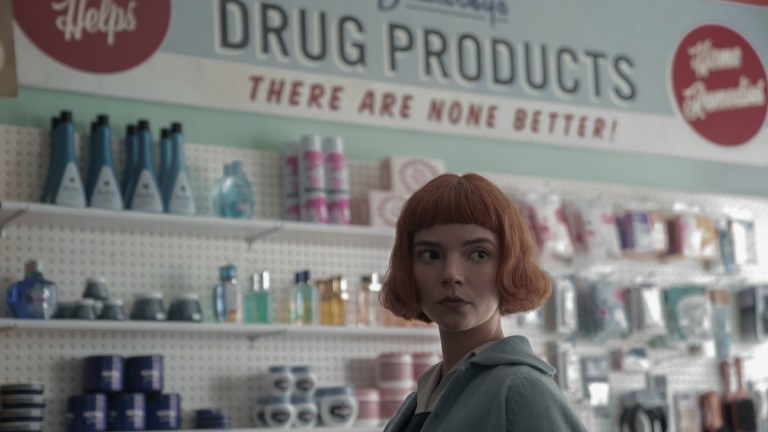The Queen’s Gambit: The Real History Behind Beth’s Green Pills
Are the green pills in Netflix’s The Queen’s Gambit for real? Well, yes...and no.

This article contains spoilers for The Queen’s Gambit.
Netflix’s The Queen’s Gambit dramatizes the unprecedented rise of (fictional) chess prodigy Elizabeth Harmon (Anya Taylor-Joy) through the grandmaster ranks of chess champions in the 1950s and ‘60s. But as with other prestige television series, there is a dark side to this savant’s talents: While she possesses a natural affinity for complex and creative chess moves, Beth is also constrained by her growing drug addiction, which she believes allows her to prevail in so many harrowing chess matches.
Even before she touches a pawn for the first time, these little green tranquilizer pills define Beth’s life and her value, from her very first day at a Kentucky orphanage. But are the pills in The Queen’s Gambit real, or a TV construct? Like Beth’s story, the pills—called Xanzolam in the series—are a historical fiction, drawing upon real benzodiazepines and their checkered history.
In her childhood, Beth knows them only as one of two “vitamins”—one red, one green—that she receives at the orphanage to help “even out” her disposition. In Water Tevis’ 1983 novel The Queen’s Gambit, on which the miniseries is based, the tranquilizers are an immediate part of Beth’s story: Beth’s disposition was all right, as far as anyone could see, but she was glad to get the little pill. It loosened something deep in her stomach and helped her doze away the tense hours in the orphanage.
In the series, fellow orphan-turned-older sister figure Jolene (Moses Ingram) slyly advises Beth to wait and take the green ones right before bed, “otherwise they turn off right when you need them to turn on.” For Beth, that means that they put her in an altered state; once she is introduced to a chessboard, the pills allow her to hallucinate the pieces on her bedroom ceiling, mapping out moves late into the night.
While Beth’s reactions to the sedatives initially seem quaint, it soon becomes clear that the child has gotten hooked. Soon after her arrival, the orphanage stops administering the green “vitamins” after they are banned for their habit-forming tendencies—but by then Beth is experiencing withdrawal symptoms. Her desperate attempt to break into the orphanage’s pharmacy at the end of the first episode sets the series’ tone for gripping cinematography, with the shot of Beth collapsed among the scattered pills she so craves.
This stage of Beth’s life also has stakes in reality: A 2018 BuzzFeed investigation into the Catholic orphanage system in 20th century North America found evidence and accounts of nuns-turned-nurses administering intravenous sedatives to orphans.
After that stunt, the pills leave Beth’s life for years; she may never have encountered them again if it weren’t for her stepmother, Alma Wheatley (Marielle Heller), and her need for “tranquility medicine” to ease the pain of her unfulfilled artist dreams: She has Beth refill a prescription for none other than familiar green Xanzolam, which helps “even out” both mother and daughter in different ways.
While the name Xanzolam is fictional, the pill is clearly intended to be a stand-in for real-life benzodiazepines, tranquilizer drugs that act on the brain and central nervous system in order to reduce anxiety, soothe insomnia, and (ironically) treat withdrawal symptoms. Intended as a safer alternative to barbiturates, “benzos” were often abused by being taken far beyond the recommended short-term period of treatment. Developed in the 1950s, benzos were a fixture in society by the 1960s, with doctors regularly prescribing “Mother’s Little Helper” as a quick fix for housewives’ ennui.
Specifically, Newsweek draws a connection between Xanzolam and the sedative Librium (chlordiazepoxide). Patented in 1958 and approved for medical use in 1960, it was the first benzo to be synthesized. By 1975, it was the fourth highest-selling pill in the United States, but that same year the DEA instituted controls to curb the usage.
Clearly, benzodiazepines are the period-appropriate drug of choice for The Queen’s Gambit, though the series introduces the notion of controls earlier in the 1960s, which is part of what makes the pill so unattainable for Beth until her adolescence. Despite the controls of the ‘70s, it wasn’t until the 1980s that scientists publicly identified the addictive qualities of such drugs, as well as their euphoric side effects that contributed to an increase in recreational usage and abuse.
As Beth moves up through the grandmaster ranks, steadily trouncing her mostly male opponents, her trajectory is weighted down by her dependence on Xanzolam: In addition to her nighttime dosage, she makes a ritual out of swallowing some green pills right before matches, to put her in that altered state during actual gameplay against a flesh-and-blood opponent instead of just her own mind playing out moves. That euphoria brings her crashing down more than once, as late-night partying and overindulging in alcohol the night before her big match against Vasily Borgov in Paris has her quite literally off her game.
In addition to drawing from historical abuse of benzodiazepines, Tevis also incorporated his own personal experiences with addiction. Diagnosed at age 9 with rheumatic heart and Sydenham’s chorea, he was placed in a convalescent home as a child. As he told Chess Life in 1983, he spent two years in that hospital, from ages 9 to 11, receiving regular doses of the sedative phenobarbital. In adulthood, he was also a recovered alcoholic. “Beth’s addiction to pills reflects that,” he told the magazine, adding that, “I love Beth. I’m touched by her ability to find what she can do best—stay with it—and be able to survive and deliver.”
The Queen’s Gambit is streaming now on Netflix.


